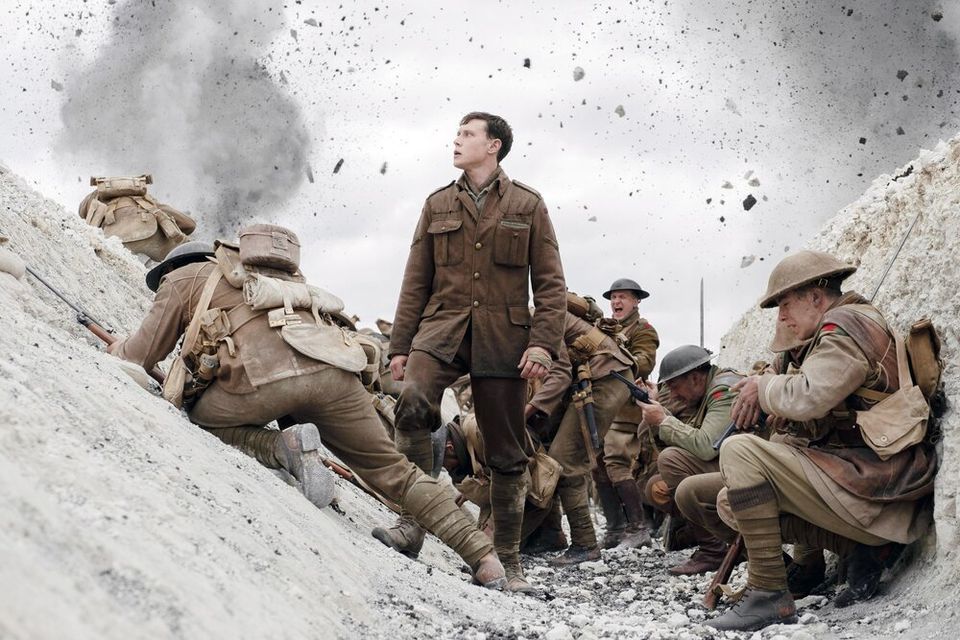'1917' is a fable that puts the horrors and heroes of war in conflict

Even if you have not had a chance to catch up on 1917, the Sam Mendes-directed World War One epic and once presumed front runner to be the 2020 Best Picture, you are probably still aware that it’s all shot in one take.
If you have seen the film you’ll recall that at the half-way point George MacKay’s Lance Cpl. Schofield is grazed by a bullet that sends him pummeling down a flight of stairs into a dark unconscious state. Seconds pass for us, and yet the dying light of dusk becomes the early dark of morning for Schofield. The “one-shot” film is severed by a clean break.
I found this obvious antithesis to the films “gimmick” amusing in the way it made the film - both its plot and very existence thinly grandiose. In reality, the mid-point break, along with the hidden cuts that keep the idea of the film sustained at a surface level, is an interesting analogy for how war stories are always told. All surface-level tales of war heroism, be they depictions of heroic soldiers, generals - or in this case a director -, require such “untruths” to work in service of the story’s ultimate success.
1917, like all tales from the battlefield - be they oral, cinematic, or on a page - has a progression that is patch-worked and anecdotal, day becomes night, and night becomes day in the span of a few hours yes, but bullets from enemies near and far also just so happen to miss our heroes time and time again. Like a dream, the journey is bookmarked by characters familiar and strange each emerging from the chaos and rubble despite their impossibility. Wild leaps and risks pay off again and again. Danger always comes close to ending the story but always manages to fail by the slimmest of margins. Real war, we know, sees these motifs far less often than cinematic war. That is because real war is a real war and does not, nor ever will, feel the need to bind itself to a three-act structure.
The continuous shot brilliantly mutes 1917’s narrative inconsistencies, its most compelling function however is to invite the audience to simply not notice them willingly. Mendes asks us, like all great purveyors of battlefield lore, to take the grandiosity as face-value even if it is paper-thin. It’s the unfolding of the story that’s important. It’s the lesson you ought to take from it that is the real truth. But with stories of war, it’s important to criticize what that lesson is.
Despite one’s efforts it’s tough to make a war movie that’s anti-war. Mendes is leaning into a long series of tricks to accomplish this, tricks particular to the World War One genre specifically. Films like All Quiet on the Western Front, or Gallopili depict the waiting, anticipation and sudden blunt violence a human cog in the trench warfare machine was subject to. World War One films are claustrophobic and contained - the attempt is to simulate the encroaching environment of the trenches which were designed to dehumanize and sacrifice a bulk mass of lives for every inch of progress. Still, stories need heroes - and it’s in the way these stories rely on a heroic arc that muddies the water.
There is a key subversion in this film that sets 1917 apart from the canon of films on The Great War. Mendes eventually breaks tradition by catapulting his leads beyond the claustrophobic trenches in its opening act, relying on that continuous camera trick to build in a feeling of movement and propulsion. The horrors of war are still present, in the hunched and bloated corpses of fallen soldiers, in the crowded flurry of mess tents where men scream for their lives. But in Mendes’ take the “heroes” in their “unheroic” setting are elevated to a higher contradiction than most.
To be clear, in doing so Mendes has found a way to tell a damn good war story, one reportedly passed onto Mendes from his own grandfather who fought during First World War and whose contribution to the film kicks off the credit sequence.
With that acknowledgment, we can understand our plot’s origin, or at least the origin of the stories it combines into a whole. Their grandiosity and their myth-building can be traced back to the same trenches where the film finds its setting. Perhaps, two good old boys, lost to history, had once been sent on a suicide mission against all odds to save an entire legion of their comrades. Following this, their success, be it real or forged, was passed from one soldier to the next, each embellishing the tale as needed until it eventually worked its way to us in a theater.
So yes 1917 seems a bit too perfect to be real. Soldiers, as we know, brought home stories of heroism to gloss over the deep traumas they experienced. It can be too easy to continue their tradition, popcorn in hand, by returning to those stories as a way to distance ourselves from the very real modern-day traumas war still creates all around us.
1917 is a perfect film to grapple with this balance, the perfect film to ask what war stories should be for - are they necessary tales of unbridled heroism we should aspire to, or are they lessons on the ultimate futility of conflict, and its irreconcilable nature (be it near or far) to a civil society.
1917 is available in wide release across Toronto.





